.
When it suddenly smells of summer at the end of May/beginning of June – sweet, flowery and a bit like childhood – then it’s elderflower time! And as this fragrance is too precious to enjoy just on a walk, I preserve it every year with my homemade elderflower syrup.
Elderflower syrup is not only a classic but also wonderfully versatile. Whether you add it to sparkling wine, use it as a lemonade, drizzle it over ice cream or scent your cake dough with it, this delicious syrup immediately lifts the mood of everyone tasting it. And the best thing about it is that you can make elderflower syrup very easily at home with this simple recipe.
When and how to forage elderflowers
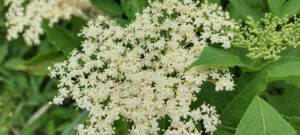
Depending on where you live, elderflowers bloom between mid-May to mid-June. When you spot them, take a basket and garden shears and head out to forage them.
Only gather umbels that grow far away from streets, at the edge of the woods, on field paths or in gardens. At those places, you can be sure that they are not polluted by exhaust fumes or other environmental toxins.
Elderflowers are quite easy to identify, but I strongly recommend you don’t pick anything if you are not 100% sure what it is. If in doubt, consult a good book on plant identification or ask somebody with experience.
Always cut the elderflower umbels with garden shears or scissors. That way, you won’t shake the flowers too much and lose their valuable pollen with the flavour.
Make sure to forage only elderflowers that are in full bloom and still fresh, meaning that the little flowers don’t fall off when shaking them. The best time for harvesting is the late morning of a sunny day. Ideally, it has been sunny for several days because that’s when the fragrance is strongest and there are hardly any insects in the flowers.
A basket is best for carrying the harvested elderflowers home, because they lie lightly and airily without being pressed too much together.
One important request: don’t overpick! Never take more than a third of umbels per bush to leave enough for bees and birds! And to come back in autumn and harvest the elderberries 😉.
Essential Equipment and Ingredients for Making Elderflower Syrup
This recipe is simple, not only because you don’t need many ingredients, but also because you certainly already have all the equipment.
Basic Equipment
You need
- A pot
- A large bowl (optional, you can also add the flowers to the liquid in the pot)
- A fine-mesh strainer or a cheese cloth to filter the syrup
- Bottles with matching lids, sterilised
- Funnel
Ingredient list
Making elderflower syrup was never easier! You just need these ingredients:
8 – 10 fresh elderflower heads in full bloom
500 g sugar
2 untreated lemons
600 ml of water
Citric acid (purely optional; I don’t like its tangy taste and don’t use it)
Elderflower Syrup: Step-by-Step Making Process
Step 1
When you’ve brought the umbels home, just shake them carefully to remove insects. If you want to be absolutely sure that no insects are left, leave the flowers outside in a dry and shady place for about 20 minutes. That way, the insects can wander off.
Do not wash the elderflowers! Their flavour lies in the pollen, and if you wash them, the pollen – and with it the flavour – would be rinsed off.
Once the elderflowers are clean, cut off the thick stems.
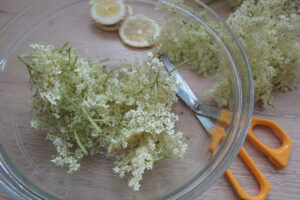
Step 2
Wash the lemons with hot water, dry them and cut them into slices.
Step 3
Mix the water and sugar in a pot and slowly bring the mixture to the boil while constantly stirring until the sugar has dissolved. Fill the sugar syrup into a bowl.
Step 4
Add the elderflowers and the lemon slices to the syrup and cover it with a cloth or lid. Let the mixture rest for 2 – 3 days and stir occasionally.
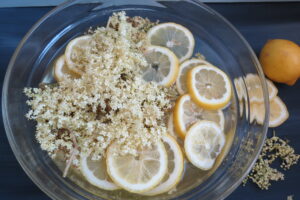
Step 5
Sterilise the bottles by rinsing them with hot water. Remove the elderflowers and lemon slices from the syrup and filter it through a fine mesh strainer. Alternatively, you can filter the syrup through a cloth and wring it out to get the last drops of elderflower syrup. If you press the flowers, the syrup may become a bit more opaque, but that’s ok.
Step 6
Fill the elderflower syrup in a pot and bring it to the boil. Fill the hot liquid into the sterilised bottles and tightly close the lids.
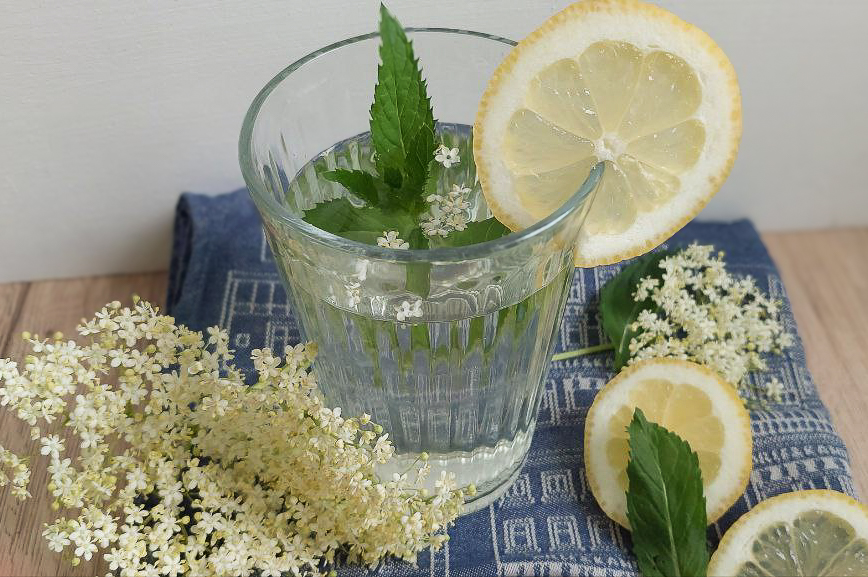
Elderflower syrup
Ingredients
Equipment
Method
- When you’ve brought the umbels home, just shake them carefully to remove insects. If you want to be absolutely sure that no insects are left, leave the flowers outside in a dry and shady place for about 20 minutes. That way, the insects can wander off.Do not wash the elderflowers! Their flavour lies in the pollen, and if you wash them, the pollen – and with it the flavour – would be rinsed off.
- Once the elderflowers are clean, cut off the thick stems.
- Wash the lemons with hot water, dry them and cut them into slices.

- Mix the water and sugar in a pot and slowly bring the mixture to the boil while constantly stirring until the sugar has dissolved. Fill the sugar syrup into a bowl.
- Add the elderflowers and the lemon slices to the syrup and cover it with a cloth or lid. Let the mixture rest for 2 – 3 days and stir occasionally.

- Sterilise the bottles by rinsing them with hot water. Remove the elderflowers and lemon slices from the syrup and filter it through a fine mesh strainer. Alternatively, you can filter the syrup through a cloth and wring it out to get the last drops of elderflower syrup. If you press the flowers, the syrup may become a bit more opaque, but that’s ok.
- Fill the elderflower syrup in a pot and bring it to the boil. Fill the hot liquid into the sterilised bottles and tightly close the lids.
Notes
How Long Can You Store Elderflower Syrup?
You can either consume the elderflower syrup as soon as it’s ready (after 2 – 3 days). Kept in the fridge, it’ll last for about 10 days.
Alternatively, you can boil the filtered syrup and fill the hot liquid into bottles. Stored in a cool and shady place (your basement, for example), it lasts up to one year.
Another way to store elderflower syrup is to put it in the freezer, where it will also last up to one year.
Flavour Variations and Enhancements
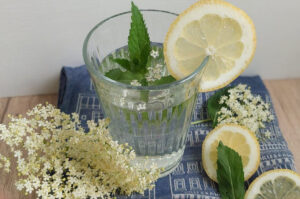
The classic elderflower syrup, as described above, is a treat in itself. However, if you want to get creative, you can vary and enhance the flavours by adding other ingredients:
- Add the slices of an orange to the sugar infusion
- Instead of lemons, use limes
- Add a stem of mint and/or lemon verbena to the syrup
- Put 3 – 5 slices of ginger into the mixture and let it steep for 2 – 3 days
- You can even adjust the level of sweetness to your taste. However, the less sugar you use, the shorter the storage time of the syrup, even when it’s boiled.
Creative Uses and Serving Suggestions for Elderflower Syrup
Elderflower syrup is incredibly versatile. Here are some ideas on how to use it:
- Fill it up with cold (sparkling) water and you’ve got a refreshing lemonade. Additionally, you might add several mint leaves and cucumber slices.
- Mixed with prosecco, elderflower syrup makes a wonderful summer cocktail.
- Speaking of cocktails: elderflower syrup is also a great additive for gin and tonics and mojitos. Just saying…
- Next time you serve a fruit salad, yoghurt or ice cream, drizzle some elderflower syrup over it to give it that extra taste of summer.
- Elderflower syrup can be wonderfully made into a sorbet or ice cream
- You can flavour cakes and pastries by adding elderflower syrup to the dough or the fillings.
- Have you ever tried flavouring your pancake dough with elderflower syrup? Well, you should!
- A bottle of elderflower syrup is a great homemade gift that everybody likes.
Troubleshooting Common Issues
Making elderflower syrup is very simple. However, there are some issues that you may face. Here’s what you can do about them:
The syrup is too sweet or not sweet enough
If it’s too sweet, you have used too much sugar; if it’s not sweet enough, too little.
In the first case, I’d recommend making a second batch of elderflower syrup with a little less sugar than indicated (e.g. 300 g) and mixing both batches to adjust the sweetness.
If the syrup is not sweet enough, don’t just add sugar to it, because it won’t dissolve properly. Instead, add sugar to about a third of the syrup and heat it up while constantly stirring until the sugar has completely dissolved. Add this to the remaining syrup and preserve it as described in the recipe.
The syrup’s cloudy
A certain opaqueness is normal, especially when you squeeze out the elderflowers into the syrup when filtering it off. That’s the pollen that carries the flavour, and it’s not harmful.
However, if the syrup shows white (or – heaven forbid – black) streaks and smells sour, alcoholic or vinegary, pour it away. It may have fermented spontaneously (see below).
The flavour is too weak.
Usually, if your elderflower syrup has only a weak flavour, you’ve used too few elderflowers. If the umbels are very small, you may have to add some more. Filter the syrup, add some fresh elderflowers and let the mixture steep for 24 hours before filtering.
Another reason for a weak flavour is that the elderflowers you used were too old. They should be freshly opened when you gather them from the tree, and not lose their tiny flowers when shaking them or even have already gone brown. That’s a clear sign of over-mature flowers. Pick fresh ones instead, and if there aren’t any left, make sure you harvest them earlier next year 😉.
However, if you can’t lay your hands on more elderflowers, a weak-tasting elderflower syrup needn’t be thrown away. Add some mint leaves and, if you like, some slices of lemon, and let it steep for 24 hours. That way, you get a lemon-mint syrup with a hint of elderflowers.
The syrup ferments
If you have used no other ingredients than the ones mentioned in the recipe and the elderflower syrup forms bubbles and smells sour, alcoholic or vinegary, I’m sorry to say you’ll have to throw it away. It has fermented spontaneously. This happens when natural yeasts on the elderflowers begin fermenting the sugar in your syrup, creating alcohol. The risk increases if you infuse the flowers for too long – beyond 3-4 days can trigger spontaneous fermentation.
Another fermentation issue may be the growth of mould, which is also due to the uncontrolled growth of undesired bacteria.
All these issues can be prevented by the following factors:
- Timing control: don’t let the infusion steep for more than 2 -3 days. I know there are recipes out there suggesting up to one week of infusion, but with every day, the risk of fermentation increases.
- Acidity: Adding lemon slices, juice, or citric acid helps to keep the “bad” bacteria at bay and thus prevents spontaneous fermentation.
- Hygiene: Sterilise all your equipment and pick flowers only from unpolluted areas
- Temperature: Pasteurising the elderflower syrup before filling it into bottles kills most of the yeast and bacteria in it. After opening a bottle, keep it in the fridge and consume it within a week.
Conclusion: Elderflower syrup is Summer to Drink!
For me, making elderflower syrup has become a yearly ritual. The glorious scent, the harvest, the bottling – it all has a soothing effect. And no matter how the weather is: every glass of elderflower syrup brings a little piece of summer to drink.
Wanna read more on how to preserve nature in a jar? Read on here:
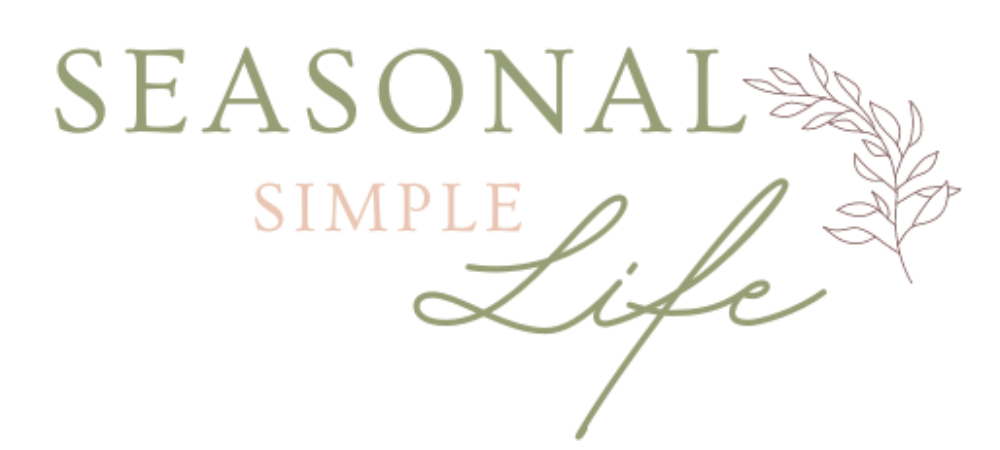
0 Comments